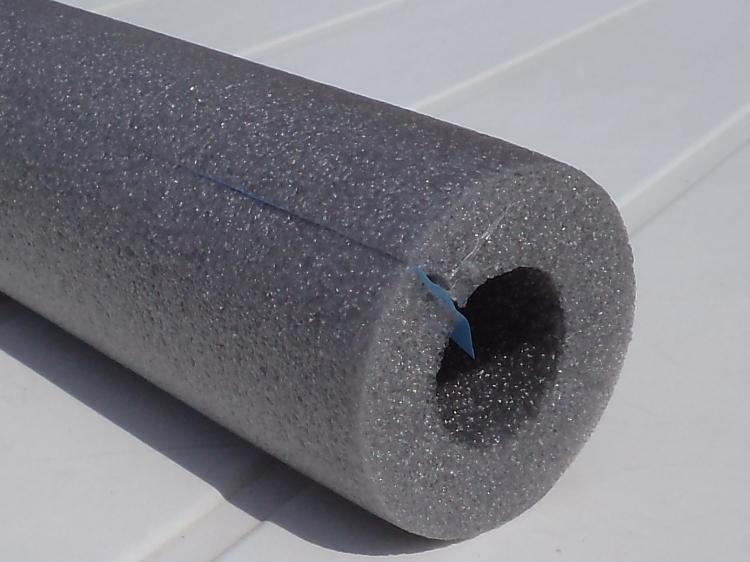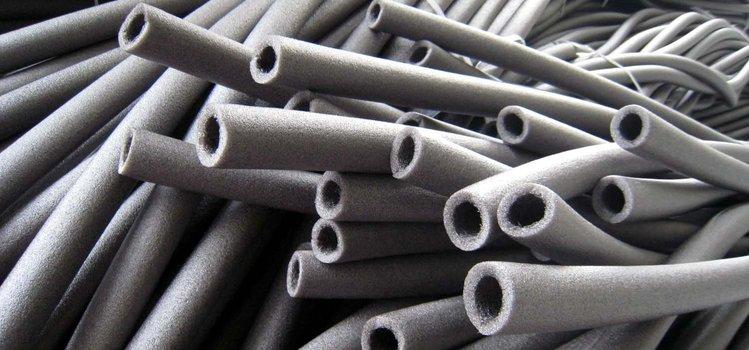Foamed polyethylene tubes are a cylindrical insulation with a closed-cell structure for insulation of steel, copper and plastic pipes. Thermal insulation for pipes made of foamed polyethylene in addition to high resistance to heat transfer is characterized by absolute waterproofness, flexibility and high sound insulation. Convenience of installation, environmental friendliness and resistance to negative environmental influences determine its widespread distribution.
Content
Where is the insulation used for foam polyethylene pipes
Engineering communications during their service life are exposed to the negative effects of liquid media, temperature and mechanical fluctuations. Insulation avoids unscheduled repairs and prolongs the life of the unit. And most importantly - to prevent internal icing, the most common cause of breakthroughs in the cold season. Most often, industrial and civil engineering use pipes made of steel, polymeric materials or fiberglass. These materials have high thermal conductivity, as a result of which they quickly freeze. By arranging thermal insulation from polyethylene, you can be sure that the working medium of the pipeline will not freeze at negative air temperature.
Foamed polyethylene is a universal insulating material, therefore it is used for internal and external communications in domestic and industrial construction. Pipe insulation made of foamed polyethylene is used for insulation:
- heating systems;
- ventilation and air conditioning installations;
- pipelines of hot and cold water supply;
- sewer networks;
- enclosing structures;
- in refrigeration units.
The minimum value of the inner diameter of the insulating tubes is 7 mm, the maximum is 160 mm. Depending on the operating conditions, the thickness of the protective layer varies between 6-20 mm.
Note! For insulation of pipelines with a diameter of more than 160 mm, foamed polyethylene is used in sheets or rolls.

PE foam tubes are used both as an independent insulation and in combination with other types of insulation materials
The most popular product size is 2 m. In the case when the pipe is longer than the insulation, installation problems do not arise. The missing piece is delivered joint to joint, and the end face is sealed with aluminum self-adhesive tape. The surface of the tubes can be gray, or painted blue or red to protect against the damaging effects of ultraviolet radiation. On one side of the insulation, thin aluminum foil can be applied to reflect heat.
Positive and negative sides of foamed polyethylene insulation
Foamed polyethylene for pipes, like any material, has strengths and weaknesses. Next, consider them, starting with the positive properties:
- High thermal insulation. The use of tubes reduces heat loss by up to 80% and ensures the same temperature of the liquid during pumping.
- Low moisture absorption no more than 2%. Thus, the pipeline is reliably protected from corrosion and the heat-insulating properties are not reduced.
- Good vapor barrier. The insulated surface does not fog up, condensation does not form. This feature provides additional benefits - savings on waterproofing.
- Operation in difficult conditions. A tube made of this material withstands temperature extremes from -80 to + 95 ° C.
- Soundproofing. Reduces structural noise, absorbs sounds from communications during the circulation of liquids. The sound absorption index of foamed polyethylene is 16 dB.
- Light weight. The use of tubes does not increase the load on the insulated object.
- Easy installation. Arrangement of isolation does not require special skills, equipment and protective equipment.
- Safety for humans and the environment. Tubes are manufactured without the use of toxic substances, do not emit dust and fibers during operation, which allows them to be used in areas with increased sanitary and hygienic requirements (medicine, food production).
- High mechanical strength. The insulation does not deform; when compressed, it quickly restores its original shape, which allows it to be used without additional protective coating.
- Long operation. The standard insulation life is at least 25 years.
- Chemical and biological resistance. Tubes do not lose their properties in contact with cement, lime and gypsum mortars, concrete, oils and other aggressive materials. Polyethylene does not decay and is resistant to mold and mildew.

An important advantage of such insulation is the ease of installation, which does not require special additional materials and tools
Among all the characteristics of foamed polyethylene, only two negative aspects can be distinguished.
1. Moderate flammability. Foamed polyethylene according to GOST 30244-94 belongs to group G2, which means it melts 30-40 seconds after direct exposure to fire. Insulation can not be used in an industrial environment with a risk of fire.
2. Destroyed by ultraviolet radiation. Direct sunlight destroys the insulation, this must be taken into account during its storage and installation.
Production, installation and maintenance of polyethylene insulating tubes
The insulation is extruded from high pressure polyethylene. As a result, it is transformed into an elastic polymer composition, which is enriched with extinguishing agents. These additives give the material the desired fire resistance and other characteristics.
The production of foamed polyethylene is as follows: the granular material is melted in special containers, where liquefied isobutane is subsequently added. It acts as a foaming reagent, and is responsible for the formation of a certain structure in the insulation. As a result of foaming, the size of the initial material increases by 20 times.
Installation of finished shells made of foamed polyethylene is easy and simple. First you need to prepare an insulated surface - clean it from dirt and rust. It is possible to fix thermal insulation both on new systems before their installation, and on those put into operation. If the pipes are not connected to the system, a protective tube is pulled over each part. When insulating pipes of small diameters, there is no need for additional cuts on the arcs and elbows.
Helpful advice! The outer diameter of the insulating tube should correspond to the outer diameter of the insulated pipe. It is not difficult to select insulation, because modern manufacturers provide high accuracy of diameters and thicknesses of products.

Each tube has a technological cut, which allows easy installation and dismantling of the insulating layer
In the case of operated pipes, there is no need to dismantle them for thermal insulation. A special technological cut allows you to quickly and evenly cut the insulating material. The resulting joint is treated with adhesive or metallized tape. It remains only to wrap the pipeline with insulation, and to press the joint for gluing.
If necessary, the insulating tube is easily removed, so there are no additional difficulties when accessing for repair and maintenance of utilities. In case of damage to the insulation shell itself, it is possible to quickly change it. Repair and installation work is necessary when the engineering system is switched off with room surface temperature.
Thus, taking into account the unique performance characteristics and low cost of foamed polyethylene, its heaters deservedly occupy a leading position in the domestic market. The use of polyethylene allows to achieve very high-quality thermal insulation, due to the low thermal conductivity, moisture resistance, elasticity and durability of the material.
